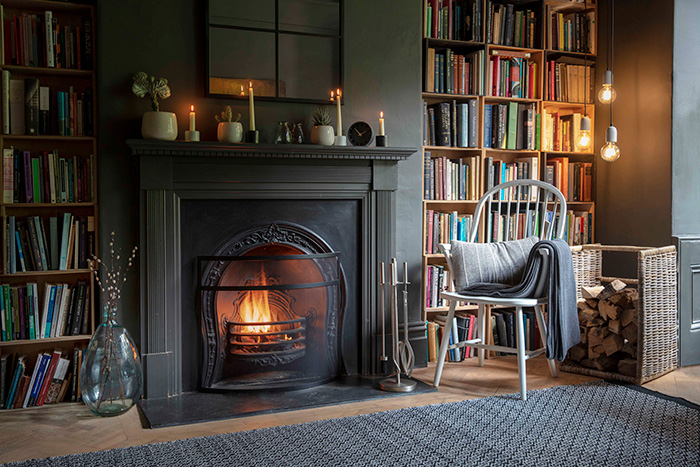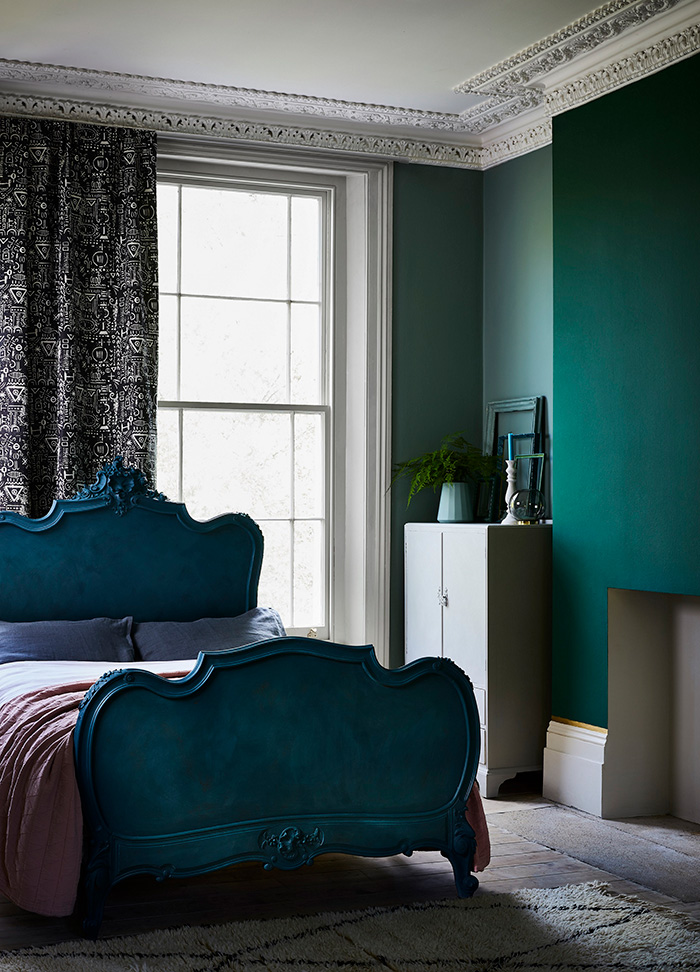The essential guide to period features
victorycolours.co.uk
Add, restore or enhance period details in your home to make any space shine
As domestic dwellings have evolved over time, each era is notable by its own particular style, from the graceful high ceilings of Georgian homes to the Edwardian penchant for parquet. Many of these period features remain in homes up and down the country, in varying states of repair. Some are hiding under layers of paint and ad-hoc boxing in, many are taken for granted, while others have sadly been ripped out altogether. But whether you live in a Victorian terrace or a modern new-build, period features can be brought to life or installed to give maximum impact and depth to a space. Here are some of the most favoured features to refine your home.

anniesloan.com
Fireplaces
There’s no beating a fireplace and surround in a main living room – it gives the space a focal point and anchor. The Victorians had a fireplace in every room, which were first made from marble or slate, but later cast iron, with colourful tiles inset on either side. So if you live in a home from this era it’s likely that a fireplace will remain at least in the sitting room, hiding behind plasterboard in the bedrooms, or sometimes in a hallway too. Homes from other periods would also have had a fireplace – you may be lucky and discover a large inglenook or an art deco piece.
If you live in a period home and the fireplaces are missing, very carefully check behind an existing modern fireplace or boarded-up chimney breast. But don’t take a sledgehammer to the wall without first checking that there’s likely to be a fireplace behind it. Do this by either knocking on the wall (a hollow sound suggests there is space behind it, which could indicate a fireplace), checking your survey, which may indicate where fireplaces once were, or if the chimney remains in place count the number of flues, which will correspond with the number of fireplaces.

gardentrading.co.uk
If the fireplace has been removed, or you’re in a modern home and want to add a focal point to a room, consider installing a period fire surround. Received wisdom has it that you should match the piece to the home’s era, but if you find something that you love, and it fits the proportions of the room and the rest of your scheme, then there’s no reason why you shouldn’t have, say, a Georgian fireplace in a mid-century home.
If this is purely for decoration, then a competent DIYer could do the job. But if it’s a working fireplace you’re after, then it’s vital to consult an expert to ensure that the chimney is clean and unblocked. Poorly maintained old chimneys and fireplaces can produce carbon monoxide, so don’t be tempted to light a fire without being given the all-clear. Also check that you’re permitted to burn solid fuel in your area; eco, smokeless fuel is best.
Top tips
- Once you uncover a fireplace it’s quite likely to be messy, so keep in mind that you’ll need to clean it out, repoint brickwork or install a chimney balloon (if you’re not going to light a fire) to eliminate draughts
- Ensure that a working fireplace is kept clean and the chimney regularly swept
- For a decorative period fireplace, add fireside tools, lights in the grate and a seasonal mantel display for a year-round focal point

anniesloan.com
Ceiling treatments
Cornicing and ceiling roses add elegance to a room and can turn any space from bland to beautiful. Plaster mouldings have been used throughout ancient history and classical architecture, and many pre-Victorian mouldings in domestic homes were copied from historical examples, with decorative plasterwork used to indicate social hierarchy.
Most period homes will retain their original cornicing – used to disguise where the walls and ceiling meet – although layers of paint could mean it’s not looking the best. If this is the case, a paint-stripping job (always check paint stripper on a small area first) may be in order to reveal the finer details. If the ceiling treatments are damaged – or the ceiling rose is missing – they’re well worth replacing. In this case, it’s better to choose pieces to match the era of your home: so a Victorian terrace will need a simpler, less ornate treatment than a large Georgian property. Also, try to ensure that both the cornice and the rose are from the same period, otherwise they could jar against each other.

anniesloan.com
You can put up a ceiling rose by drilling into the ceiling with plaster screws and securing it with cornice glue, but rewiring the light back in should be done by a qualified electrician. Adding cornicing to a modern home, or replacing old plasterwork, is a much larger job and will require an experienced builder.
Traditionally ceilings, including plaster mouldings, were painted white. Now, though, everything from inky blue to pink can add impact to a space. Painting the wall a dark colour and the cornice and ceiling a pale hue creates a dramatic effect and makes the ceiling look higher. Or, choose your wall and ceiling colour and pick out the cornicing in a tone in-between for a graduating effect.
Top tips
- Ceiling roses come in a huge number of styles, from pared-back and diminutive to large and ornate. Generally speaking, the higher the ceiling, the more elaborate you can go with the rose
- If your roses have been removed, it’s worth asking a neighbour with a similar-era home to see their ceiling treatments, to give you an idea of what was originally installed

pooky.com
Dado and picture rails
These simple additions really enhance a room and instantly add character. Picture rails first became common around the early 1800s and were mounted either about 40cm below the ceiling cornice, or at the same height as the top of the windows or doors. Dado rails originally came about in the Georgian era, when dining chairs were put away from the table when not in use. The wooden dado rail, fixed at around 120cm from the floor, was to protect the wall from being knocked by furniture. Today, while we tend not to use picture rails for our wall art and dado rails serve no practical purpose, both are good ways to make a decorative statement and provide opportunities to use bold colour, wallpaper or panelling either above or below them.
Consider fixing dado rails slightly lower than they would have been originally, as this makes the ceiling look higher. Take your guide from the ceiling height – there’s no set rule, but if you live in a period property and the dado has been removed, then look for bumps in the plasterwork.

anniesloan.com
Picture and dado rails are simple to glue on with something like No More Nails, but bear in mind that it’s a very precise job that’s hard to rectify if you find your lines aren’t straight.
Pick out your dado or picture rail in white or an accent colour to draw a line between, say, paint and wallpaper, or paint the rails in the same colour as the wall for a contemporary look.
Top tips
- A room with a dado rail requires a lower skirting board
- Choose between a picture or dado rail for a lower-ceilinged room; having both can make it look cluttered
Before you go...
...fancy automatic entry to all future competitions?
Simply register online today for FREE and you will get:
Automatic entry to all current and future competitions.
Access to Reclaim Inspiration - an online visual pinboard for saving all your home and style inspiration.
A regular newsletter of inspiration, ideas and advice.

Save all your articles in one place
Become a Reclaim Member to save all your home and style inspiration. Simply login or register online today for FREE and you will get:
Automatic entry to all current and future competitions.
Access to Reclaim Inspiration - an online visual pinboard for saving all your home and style inspiration.
A regular newsletter of inspiration, ideas and advice.








